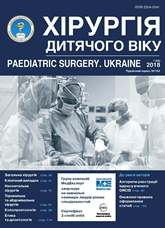Use of prophylactic phytocylinders with a lipophilic complex of rose hips and chamomile extract for the anal fissures and constipation treatment in children
DOI:
https://doi.org/10.15574/PS.2018.58.98Keywords:
phytocylinders anal fissure, treatment, childrenAbstract
Objective – to study the efficacy of prophylactic phytocylinders with a lipophilic complex of rose hips and chamomile extract (Scientific and Production LLC «Zhitomirbioprodukt») in children with anal fissures and constipation.Material and methods. The comprehensive examination and treatment of 42 children with anal fissures and constipation were performed. The first group included 20 (47.6%) children who received the prophylactic phytocylinders with a lipophilic complex of rose hips and chamomile extract during 10 days every day in the form of rectal suppositories 1–2 times per day. The second group comprised 22 (52.4%) children who received standard treatment according to the protocol.
Results and conclusions. Against the background of the comprehensive treatment for anal fissures and constipation with the prophylactic phytocylinders with a lipophilic complex of rose hips and chamomile extract, there was a more pronounced treatment efficacy in comparison with basic therapy alone. This justifies the necessity of their use in children with this pathology.
References
Baranova AA, Klimanskoy EV, Rimarchuk GV. (redaktoryi). (2002). Detskaya gastroenterologiya (izbrannyie glavyi). Moskva.
Berdnikova EK, Keshishyan ES. (2007). Funktsionalnyie narusheniya zheludochno-kishechnogo trakta u detey rannego vozrasta. Consilium Medicum. Pediatriya. 9(1): 13–17.
Bielousov YuV, Voloshyna LH, Pavlenko NV, Solodovnychenko IH, Babadzhanian OM. (2007). Zakhvoriuvannia orhaniv travlennia u ditei (standarty diahnostyky ta likuvannia): navchalnyi posibnyk dlia pediatriv, dytiachykh hastroenterolohiv, likariv zahalnoi praktyky – simeinoi medytsyny. Kharkiv: INZhEK.
Maidannyk VH. (2007). Rymski kryterii III (2006) diahnostyky funktsionalnykh hastrointestynalnykh rozladiv u ditei. Pediatriia, akusherstvo ta hinekolohiia. 3: 5–13.
Barrett KE, Ghishan FK, Merchant JL, Said HM, Wood JD, Joh LR (Eds.). (2006). Physiology of the Gastrointestinal Tract. 2 vol. Set: Academic Press. https://doi.org/10.1016/B978-012088394-3/50079-9
Bassotti G, de Roberto G, Castellani D, Sediari L, Morelli A. (2005). Normal aspects of colorectal motility and abnormalities in slow transit constipation. World J Gastroenterol. 11 (18): 2691–2696.
Biggs WS, Dery WH. (2006). Evaluation and treatment of constipation in infants and children. Am. Fam. Physician. 73: 469–482.
Boccia G, Buonavolonta R, Coccorullo P et al. (2008). Dyspeptic symptoms in children: the result of a constipation-induced cologastric brake? Clin Gastroenterol Hepatol. 6 (5): 556–560.
Downloads
Issue
Section
License
The policy of the Journal “PAEDIATRIC SURGERY. UKRAINE” is compatible with the vast majority of funders' of open access and self-archiving policies. The journal provides immediate open access route being convinced that everyone – not only scientists - can benefit from research results, and publishes articles exclusively under open access distribution, with a Creative Commons Attribution-Noncommercial 4.0 international license(СС BY-NC).
Authors transfer the copyright to the Journal “PAEDIATRIC SURGERY.UKRAINE” when the manuscript is accepted for publication. Authors declare that this manuscript has not been published nor is under simultaneous consideration for publication elsewhere. After publication, the articles become freely available on-line to the public.
Readers have the right to use, distribute, and reproduce articles in any medium, provided the articles and the journal are properly cited.
The use of published materials for commercial purposes is strongly prohibited.

